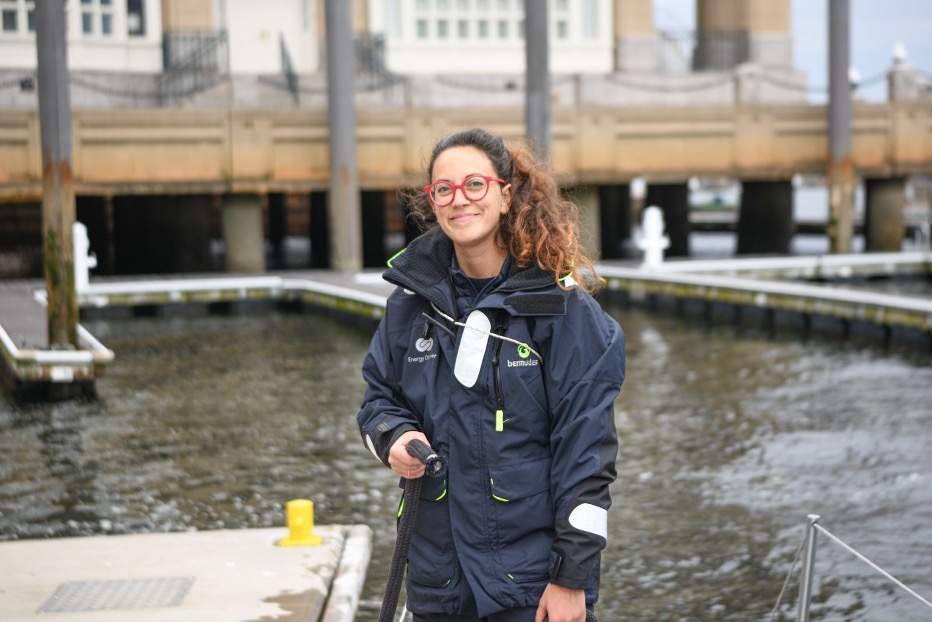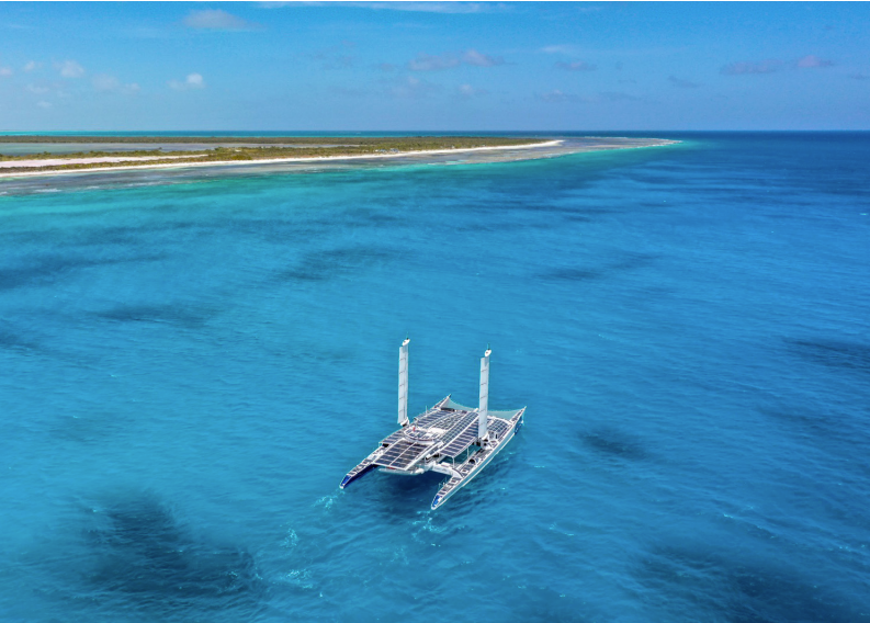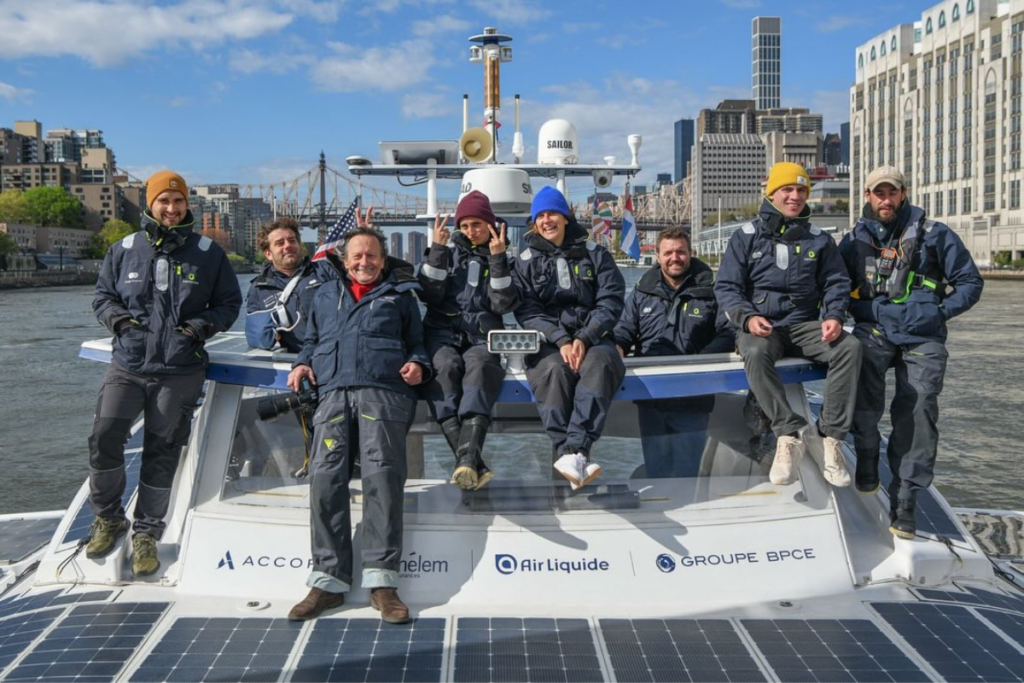The Energy Observer, the world’s first zero-emission vessel dedicated to testing technological solutions for low-carbon energy production, recently docked in the New York City harbor to display its groundbreaking looks and, most importantly, to attest to the exciting possibilities for the maritime shipping industry’s future. Eco18 interviewed onboard scientist Beatrice Cordiano, an energy engineer specializing in renewable energies and hydrogen who is also passionate about preserving ocean ecosystems, to learn about this first-of-its-kind floating laboratory.
1. Can you please tell us about yourself?
I’m the Energy Observer onboard scientist. Before joining them, I worked on research at the ETH Zurich about the production of hydrogen combined with carbon capture. It involved a lot of simulations and coding, so it was very theoretical. At some point, I wanted to apply my knowledge and expertise about these technologies in real life and the Energy Observer allowed me to see first-hand how to apply these technologies at sea.
2. What can you tell us about the Energy Observer? What is it, and why was it created?
The Energy Observer was launched in 2017 as the first vessel to navigate the globe self-sufficiently using renewable energies and hydrogen without emitting polluting emissions or noise. But it is much more than that.
Victorien Erussard, a merchant marine officer and professional sailor, viewed this vessel as a way to contribute to the planet. With this in mind, he built a team of sailors, scientists, engineers, and journalists to navigate the oceans, using solar, wind, and hydro power technologies to test them in the most adverse environment (the ocean) and prove they can be used at larger scale, helping reduce society’s carbon footprint.
3. What is the vision behind the Energy Observer?
The Energy Observer was created with two main goals in mind: technological and educational. The technological goal refers to all the onboard low-carbon cutting-edge technologies developed so they can be tested in different climates and weather conditions to push their limits and assess what works, what needs to be changed, or improved so it can be applied at a larger scale in the future.
From an educational standpoint, the idea is to show people in a relatable manner how these innovative technologies in sustainability and energy can be used. Although energy is abstract, it is part of our lives, and how we use it and produce it can disrupt all ecosystems.
During each odyssey, we meet with actors in the energy transition area, including researchers, energy experts, and policymakers, to understand the energy context of the more than 40 countries the Energy Observer has visited. We also educate about the state of the energy transition worldwide and convey a positive message about the solutions available.
4. How have people responded to the vessel?
Although it is not simple to educate people about these topics, the world tour has been very positive. The boat is a great tool to explain these technologies and how they work. It makes them more tangible, so people see concrete solutions for contributing to a more sustainable future.
5. How many crew members are part of the vessel?
We have two crews of five people each, a total of 10. Typically, the captain oversees everything: navigation, logistics, clearance, etc. We also have a system engineer to handle the new technologies, their maintenance, and any issues that may present during navigation. There is a boat lane, who is like the Swiss Army knife of the boat in charge of security. Also, there are scientists, like me and a reporter, because we document the odysseys and develop images and videos for educational purposes.
6. What is your role in the Energy Observer?
My role varies since I am an onboard scientist and a crew member. As an onboard scientist, I’m in charge of everything related to research, energy context, and energy transition in the different places where the boat stopovers. As part of this project’s educational component, we aim to raise awareness about ecological and energy transition because the two are inevitably connected, so my role is also to communicate these topics in conferences, roundtables, articles, and videos. As every crew member, I also watch, cook, clean, and do everything else you need to do on a boat.

7. How long did developing the plans and building this amazing vessel take?
Everything started in 2013, but the vessel was operational in 2017. We transformed a legendary race boat, the “Enza New Zealand” (Eat New Zealand Apples), winner of the 1993 Jules Verne Trophy. Sailors, engineers and naval architects worked together to retrofit its parts. Considering that the crew of a racing catamaran sleeps in the two hulls, and all the technologies of the Energy Observer were placed in the hulls, they needed to build a central part for the crew to live in. The CEA, a French government-funded technological research organization, worked on all the technology onboard the vessel.
8. Can you expand on how the boat works?
The vessel uses three renewable energy sources: the sun, winds, and water. Since renewables are intermittent, the Energy Observer has two energy storage methods for those long periods of lack of sun. In terms of energy production, the boat is covered in 202 square meters of different types of solar panels. Regarding winds, the vessel has ocean winds or rigid sails, which do not produce electricity but allow the crew to spare a lot of energy that otherwise would have to be put into the engines. They are also about 1.7 times more efficient than a regular sail because they are aerodynamic, like the wing of a plane.
Under the right conditions, we can produce power from our engines (hydropower) because we can change the propellers’ sense of rotation and use them as generators instead of engines.
We have short-term storage for the boat, including lithium-ion batteries with a capacity of 100 kilowatt-hours. These batteries are charged and discharged during the day. However, the problem is their weight and bulk. We could have decided to put just batteries instead of batteries and hydrogen, but if we had done so, the boat would have weighed twice as much. For long-term storage, we use hydrogen. We produce it onboard from seawater and transform it into fresh water we can drink, shower, and cook with. We then feed the pure water into electrolyzer technology, which uses an electric current to split the water molecule into hydrogen and oxygen. This hydrogen then gets compressed, and we can store it, so when we need electricity, don’t have the sun or wind, and already use the batteries’ energy, we start using hydrogen.
9. Please list the places the Energy Observer has sailed.
2017, France
2018, Mediterranean
2019, Northern Europe
2020, Atlantic
2021, Pacific
2022, Asia
2023, Africa & Brazil
2024, America
10. Was there a special reason to come to New York before retiring the vessel at the end of 2024?
The New York visit coincided with Earth Day, and it presented a unique opportunity to showcase to key stakeholders the innovative technological solutions that have been tested, deployed, and optimized, encouraging action toward a greener, more sustainable, and low-carbon future.
11. How many nautical miles has this self-sufficient boat traveled to date?
As of March 2024, the Energy Observer had sailed 62,000 nautical miles, visited over 40 countries, crossed the Atlantic, Pacific, and Indian Oceans, and made 86 stopovers.
12. Can you talk about some of the key findings of this floating laboratory?
In terms of technology, we learned how to harness the wind. In the beginning, we had two vertical-axis turbines. We tested them and realized they were inefficient because they were too heavy for the boat, which meant more energy was required to propel it. We also changed the fuel cell for a more powerful one. We now have a Toyota fuel cell, the same as one found in cars but adapted for marine applications.
We learned how solar panels respond to certain conditions and that their efficiency drops with high temperatures and high humidity ratios, so we had to change some of them. These findings are starting to be applied in other sectors; for instance, our solar panels are now used in many racing boats due to their lightweight nature. A commercial vessel called The Canopy implemented the ocean wings on the boat.

13. What does the immediate future hold for the Energy Observer?
This year will be the Energy Observer’s final expedition. In addition to visiting New York in April and Boston in May, the boat will immediately after navigate to Canada, arrive in St Malo (France) in June, and mark the end of the odyssey in Paris between July and October to coincide with the Paris 2024 Olympic and Paralympic Games.
14. Are there plans to build other vessels similar to the Energy Observer?
The next step is to produce a bigger cargo vessel that will also run on hydrogen. It will incorporate other technologies based on what was learned with the Energy Observer.
15. What is the main takeaway of this journey?
There’s not one magical solution for any situation, and the climate crisis is no different. Like on the boat, we didn’t function with only one technology but a mix that complemented each other, which is what will help us through this climate crisis. The energy mix we used was a very good solution for cleaner and decentralized energy production, and since it worked on our boat, it can also be implemented at a different scale and on land.
16. Are there other plans for the Energy Observer once it retired?
We are working on many other projects. The Energy Observer will live on through a museum of energy. We are also developing a digital platform where the educational content amassed during the seven-year expedition will live.
17. Is there anything else you would like to add?
The other lesson we learned is that technology is a great help, but we also need to adapt the way we consume energy and try to keep up with natural resources without overexploiting them. We have to adapt our way of living, our way of behaving, and our way of using resources.

18. How would the crew of the Energy Observer want her to be remembered?
We want people to remember this vessel as a pioneer of different renewable technologies, especially hydrogen at sea. The Energy Observer is also a reference about energy topics and energy transition worldwide.
 Food
Food Farmers
Farmers Sustainable Living
Sustainable Living Living Planet
Living Planet News
News